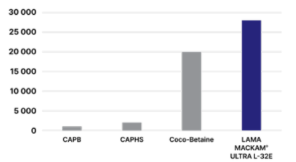Enhanced TDS
Identification & Functionality
- Blend
- No
- CASE Ingredients Functions
- Chemical Family
- Function
- Crosslinking Agent
- Product Code
- MITM00236
- Single Ingredient
- Yes
- Technologies
- Product Families
Features & Benefits
- CASE Ingredients Features
- Product Benefits
- Very high solids content
- Excellent deformation and flexibility
- Fast cure response at short dwell time
Applications & Uses
- Coating End Applications
- Compatible Polymers & Resins
- Markets
- Applications
- Product Applications
- Coil coatings
- Can and container coatings
- High solids and waterborne coatings
- Formulation Stability
- The stability of formulated systems containing CYMEL® 301 Resin can be enhanced by the addition of primary alcohols, amines or a combination of these.
- Low molecular weight primary alcohols, such as ethanol and n-butanol, are most effective.
- Recommended amines are DMEA or 2-AMP at a concentration of 0.5 1.0% on total resin solids.
- Package stability can also be enhanced by the use of a blocked acid catalyst, such as CYCAT 4045 catalyst.
- For waterborne systems, pH should be adjusted between 7.5-8.5 to achieve optimum stability
Properties
- Physical Form
- Soluble In
- Backbone Polymer Selection
- CYMEL® 301 Resin contains mainly methoxymethyl functional sites making it a highly effective crosslinker for backbone polymer resins containing hydroxyl, carboxyl, or amide functional groups, such as those found on alkyd, polyester, or acrylic resins.
- Its high monomer content and low tendency to self-condense results in films with high flexibility and formability when paired with inherently flexible polymers, such as polyester resins.
- The effective equivalent weight of CYMEL® 301 Resin typically ranges from 130-190, however, its optimum loading should be determined experimentally for each formulation with consideration of the performance properties to be optimized.
- Catalysis Information
- Because of its high extent of alkylation, CYMEL® 301 Resin responds best to sulfonic acid catalysts, like CYCAT® 4040 catalyst or CYCAT 600 catalyst.
- Generally, 0.5 to 1.0% of CYCAT 4040 catalyst on total resin solids of the formulation is sufficient to provide good cure at normal baking schedules (15-20 minutes at 120-150°C) in solvent-borne systems.
- Water-borne systems generally require temperatures of 150°C or higher to effect cure.
- Higher concentrations of catalyst might be necessary if there are basic pigments or additives present in the formulation.
Technical Details & Test Data
- Typical Thinning Curve

Packaging & Availability
Principal Information
- Group Principal Number
- S000001
- Principal
Storage & Handling
- Storage Conditions
- CYMEL® 301 Resin has a shelf life of 5 years from the date of manufacture when stored at temperatures between 5°C and 30°C.
- Although lower temperatures are not detrimental to stability, its viscosity will increase, possibly making the resin difficult to pump or pour.
- The viscosity will reduce again on warming, but care should be taken to avoid excessive local heat, as this can cause an irreversible increase in viscosity
Other
- Appearance
- Clear liquid
- Appearance (SDS)
- Viscous liquid
- Color (SDS)
- Clear
- Item Number
- Odor (SDS)
- Slight formaldehyde
- Other Hazards
- Not applicable
- Protect from Freezing
- Yes
- Temperature Control
- Yes
- USA/DOT UN Number
- Not Applicable
- Chemical Properties
Value Units Test Method / Conditions Free Formaldehyde Content max. 0.3 % % Sulfite Method - Material Composition
Value Units Test Method / Conditions Non-Volatile Content min. 98.0 - ISO 3251 - Optical Properties
Value Units Test Method / Conditions Color Scale max. 70.0 APHA APHA Color Scale max. 70.0 Gardner Gardner ISO 6271 - Physical Properties
Value Units Test Method / Conditions Storage Temperature 39.92-89.96 °F °F Viscosity 2000.0-4500.0 - ISO 3219 at 23°C - SDS Physical and Chemical Properties
Value Units Test Method / Conditions Density (SDS) 1.2 g/cm³ g/cm³ Flash Point (SDS) min. 93.0 °C °C Melting Point (SDS) 30.0-35.0 °C °C Storage Temperature (SDS) 4.4-32.2 °C °C Vapor Pressure (SDS) 0.03 - at 180°C pH (SDS) max. 2.0 - - Shelf Life & Stability
Value Units Test Method / Conditions Shelf Life 5.0 -
